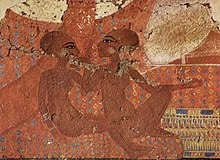| Revision as of 23:50, 28 January 2008 edit77.5.107.246 (talk) →Sculpture← Previous edit | Revision as of 23:51, 28 January 2008 edit undo77.5.107.246 (talk) →SculptureNext edit → | ||
| Line 26: | Line 26: | ||
| In this sculpture of Akhenaten, note his wide hips and drooping stomach. Much like the bust of Nefertiti above, Akhenaten's neck if elongated. His lips are thick and his arms and legs are thing and lack muscular tone, unlike his counterparts of other eras in Egyptian artwork. Some scholars suggest that the presentation of the human body as imperfect during the Amarna period is in deference to Aten. | In this sculpture of Akhenaten, note his wide hips and drooping stomach. Much like the bust of Nefertiti above, Akhenaten's neck if elongated. His lips are thick and his arms and legs are thing and lack muscular tone, unlike his counterparts of other eras in Egyptian artwork. Some scholars suggest that the presentation of the human body as imperfect during the Amarna period is in deference to Aten. | ||
| --> | --> | ||
| Excellent examples of |
Excellent examples of forgeries purportedly from the Amarna period can be found at the M.A. Mansoor Amarna Collection (http://www.mansooramarnacollection.com/) website. | ||
| ==Architecture== | ==Architecture== | ||
Revision as of 23:51, 28 January 2008

The Ancient Egyptian art style known as Amarna Art was a style of art that was adopted in the Amarna Period (i.e. during and just after the reign of Akhenaten in the late Eighteenth Dynasty, and is noticeably different from more conventional Egyptian art styles.
It is characterized by a sense of movement and activity in images, with figures having raised heads, many figures overlapping and many scenes busy and crowded. Also, the human body is portrayed differently in Amarna style artwork than Egyptian art on the whole. For instance, many depictions of Akhenaten's body give him distinctly feminine qualities, such as large hips, prominent breasts, and a larger stomach and thighs. This is a divergence from the earlier Egyptian art which shows men with perfectly chiseled bodies. Faces are still shown exclusively in profile.
The illustration of hands and feet was obviously thought to be important. They were shown with long and slender fingers, and great pains were gone to to show fingers and finger nails. Flesh was shown as being dark brown, for both males and females (contrasted with the more normal dark brown for males and light brown for females) - this could merely be convention, or depict the ‘life’ blood. Figures are now shown with both a left and a right foot, contrasting the tradition of being shown with either two left or two right feet.

Tombs
The decoration of the tombs of non-royals is quite different from previous eras. These tombs do not feature any funerary or agricultural scenes, nor do they include the tomb occupant unless he or she is depicted with a member of the royal family.
There is an absence of other gods and goddesses, apart from the Aten. However, the Aten does not shine its rays on the tomb owner, only on members of the royal family. There is no mention of Osiris or any other funerary figures; there is also no mention of a journey through the underworld. Instead, excerpts from the Hymn to the Aten are generally present.

Sculpture
Sculptures from the Amarna period are set apart from other periods of Egyptian art. One reason is the accentuation of certain features. For instance, an elongation and narrowing of the neck, sloping of the forehead and nose, prominent chin, large ears and lips, spindle-like arms and calves and large thighs, stomachs, and hips. Excellent examples of forgeries purportedly from the Amarna period can be found at the M.A. Mansoor Amarna Collection (http://www.mansooramarnacollection.com/) website.
Architecture
Not many buildings from this period have survived the ravages of later kings, partially as they were constructed out of standard size blocks, known as Talatat, which were very easy to remove and reuse.
Temples in Amarna, following the trend of Amarna, did not follow the trend of traditional Egyptian customs and were open, without ceilings, and no closing doors.